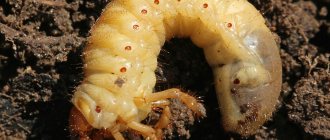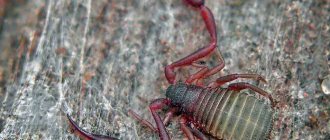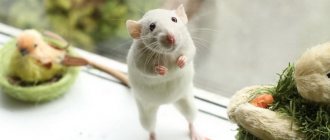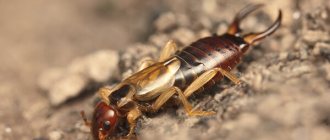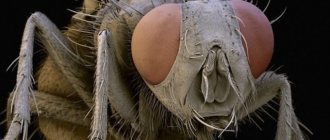Absolutely all people at least once in their lives have encountered brown or red beetles with white triangle-shaped spots on their sides in the summer. This is exactly what the cockchafer looks like; it is quite large in length - about three centimeters, and convex in width. If you touch the cockchafer with your fingers, you can feel its hard shell made of chitinous “shell”.
The beetle's body is divided into three components: head, abdomen, and chest. A similar structure is characteristic of all other insects. The chafer beetle is a phylum arthropod and its name in Latin is Melolontha Hippocastani. The first word denotes a genus of beetle, which consists of twenty-four species, and nine of them live in Russia.
The mass reproduction of beetles, as the name suggests, occurs in May. At the same time, the buds of oaks and birches begin to bloom. May beetles grow underground, and when they reach a certain period, they crawl out of the soil and immediately fly up. We can hear their buzzing in the evenings among the flowering plants. True, cockchafers are not useful for agriculture: they damage young foliage. By the way, during the day you may not find beetles among the vegetation, since they sit on bushes or trees and merge with the branches, firmly clinging to their legs.
Appearance and habitat
What does the cockchafer consist of? Like all insects, the structure of the cockchafer includes a chitinous covering in the form of a shell, which plays the role of protection from environmental irritants, and also acts as a kind of skeleton. The maximum size of the beetle is usually up to three and a half centimeters.
Adult representatives of the cockchafer often differ in their color. Of the entire color range, two variations stand out: rex - red body with a reddish tint to the legs and pronotum; nigripes - legs and pronotum are black. Such chromatism is considered an ecological form of the cockchafer's structure. Those individuals that are red and orange live in places open to the sun, while black ones live mainly in dark places in medium-density forests. Accordingly, reds predominate in the south, and blacks predominate in the north of the country.
Being part of the world of insects, the cockchafer prefers forest-steppes and forest belts with young pine trees; within city limits they are found among artificially planted plants, as well as among trees and shrubs that are flowering and fruitful. It is trees and shrubs that are considered the main place for mating, after which the female lays eggs in the soil, burrowing there with her head.
General information
Beetles are a large group of organisms living on Earth. Almost 400 thousand species are known, including 3 thousand extinct ones. Some species are presented in museum collections in a single copy, and some can only be learned from reference books and encyclopedias. Coleoptera are distributed throughout the globe, excluding Antarctica and the Arctic.
The insect's body has three main segments: head, thorax, and abdomen. The sizes of adult individuals range from 1 mm to 20 cm. As a rule, males are smaller and more mobile than females, have longer antennae and wide front legs. Males of some species have developed mandibles - outgrowths similar to horns. For example, in stag beetles they are located horizontally and have the same size, but in the rhinoceros beetle they are vertical, the upper horn is much larger than the lower one.
Beetles, like all insects, have a mixed body cavity. Their body is divided into three sections. The upper one contains the dorsal blood vessel. The digestive, excretory and reproductive systems are located in the middle. At the bottom is the ventral nerve cord.
The life cycle consists of four main stages:
- egg;
- larva;
- chrysalis;
- imago (adult).
The beetle has three sense organs:
- Mechanoreceptors - pick up sound waves, vibration, distinguish touches;
- Thermoreceptors - respond to changes in temperature;
- The eyes are the main organ of vision, consisting of omatidiae. Each ommatidia perceives a separate point in the image, so beetles see it as a mosaic consisting of individual points.
The colors of the beetles are different. In some, mainly diurnal species, it is bright: green, orange, blue, red. Such colors are determined by the way of life, and help the beetles to remain unnoticed among plants. The backs of Coleoptera are often decorated with ornaments of contrasting colors, forming beautiful patterns (stripes on the Colorado potato beetle, black spots on the ladybug and fireman beetle). May beetles and scarab beetles have metallic wings. Nocturnal beetles are predominantly dark in color: black, brown, gray.
Based on the type of nutrition, predatory and herbivorous beetles are distinguished. Predators feed on other insects and their larvae, while herbivores feed on leaves, roots, flower seeds and pollen.
Beetles have three types of communication, allowing individuals of the same species to communicate with each other. These include:
- Sounds. Representatives of 20 families have the ability for sound communication. Most often, sound is used as a scaring signal. The barbel produces sound by rubbing the chest segments. Furniture grinders hit their heads against the wall of a passage in the wood, making sounds similar to the ticking of a clock.
- Glow. Characteristic of fireflies. The common firefly emits a calling signal of an even yellow color, and South American fireflies are capable of emitting green and red colors.
- Pheromones. Necessary primarily for intersexual communication. In most species, pheromones are released by females.
The use of means of communication allows beetles to unite into clusters - groups necessary for wintering and feeding.
Stages of development
The intermediate stage of development between the egg and the adult is the larva. This is a unique developmental stage found only in insects. The larva emerges from an egg laid by the female. Its development lasts from several weeks to several years. The mature larva moves to the next stage - pupation.
In the structure of different types of larvae, common features can be identified:
- large head with gnawing mouthparts;
- elongated fleshy body;
- limbs are absent or poorly developed.
There are 3 main types of larvae:
- Campodeoid. They have a narrow long body, partially covered with dense chitinous plates, long antennae and 3 pairs of thoracic limbs.
- Eruciform. Their bodies are short, fleshy, and not protected by a shell. The limbs are short and weak or completely absent, the antennae are barely noticeable.
- Wireworms. They have a long, cylindrical body covered with a chitinous shell. Very mobile, have several pairs of short strong legs.
The color of the larvae depends on their habitat. Those living secretly (in earthen burrows, plant stems, under bark and other protected places) have a light color: milky white, yellowish, pink. Open-living, leaf-dwelling larvae are dark in color: gray, black, green.
The larvae of water beetles are classified into a separate category. In accordance with their lifestyle, they can be predatory or non-predatory. Predatory individuals are large-headed, have powerful, developed jaws, an agile short body and long legs. Non-predatory larvae are inactive; their bodies have special growths - gills, which allow them to remain under water for a long time.
Habitats
Beetles live everywhere, they can settle on land and in water bodies, and inhabit deserts and tropical forests. Only areas covered with an eternal glacier and the highest mountain peaks are unsuitable for them.
Most beetles live in the upper layers of the soil and in various parts of plants. Mycetophagous beetles settle in mushrooms and feed on their home until they completely eat it. Carrion beetles live in the carcasses of dead animals, and dung beetles live in feces.
Most aquatic beetles live in fresh water, but some species can live in brackish water. Thermophilic species are able to live in warm water; they settle in thermal springs. Some species of beetles lead a semi-aquatic lifestyle. They hunt and spend most of their time in water, but they can get onto land and change their habitat by moving to another body of water.
Some beetles live in human homes and outbuildings. Most of them are parasites that spoil stocks of animal and plant origin: grain, hay, vegetables, flour products, leather, wooden furniture. Some species can harm human health. For example, bedbugs that live on the walls of houses, in furniture and under the floors feed on blood, and their bites are very painful. They can bite adults, but they pose a particular danger to children.
Beetle body parts
The external structure of the cockchafer is identical to that of other beetles. In addition to the main parts of the body, it has a pronotum, which, together with the head, is covered with hairs of medium length; relative to the rest of the hair, they form stripes along the body. The underwing area is also covered with small hairs. The very part of the body to which the legs are attached and the head have small scales similar to hair. All limbs are divided into individual members, hence the name - Arthropods. The chest has 3 segments, and the abdomen has eight.
The use of herbal infusions, decoctions and solutions against the cockchafer
- Water the soil throughout the growing season with an infusion of onion peels. Fill 1/3 of a bucket of husks with water to the brim and leave for 5 days. The resulting infusion should be diluted with water in a ratio of 1:1
- 200 g coarse salt and 2 tbsp. spoons of ammonia are stirred in a bucket of water until the salt is completely dissolved and the area is watered
- Infusion of walnut leaves (method for the south of Russia): 300 - 400 g of fresh leaves, pour 10 liters of warm water and leave for 24 hours
- Using a solution of potassium permanganate (5 g per 1 liter of water)
Head of a cockchafer
The head includes the cockchafer's mouthparts, as well as sensory organs. Diametrically in the front part there is a place for the upper lip, behind it there are jaws, both below and above the inner part of the oral cavity, as well as the lower lip. The jaws are the lateral and inferior boundaries of the mouth. The lower jaw and lip are equipped with palps, which are used for touch and as taste buds.
The eyes are located on the left and right of the head; the structure of the eyes is complex - they consist of thousands of ordinary small eyes. For smell, the cockchafer uses a pair of antennae, at the end of which there are wide plates. An interesting fact is that these antennae are more hypersensitive in males. The head itself is pressed in from the front, as if inside the beetle, that is, it will be able to tilt its head, but will not be able to turn it.
External building
- Head . Has a mouth with lips and upper and lower jaws. They are equipped with palps for taste and tactile functions. The eyes are of a compound type, above them there is a mustache with 7 plates. The plates are the olfactory organs.
- Breast . Consists of 3 sections. Each of which has a pair of limbs. The last two have wings. Above the sternum there are elytra to protect the soft tissues of the back and thin hind wings. The paws have sharp claws, with the help of which the beetle moves well along rough wood and plant trunks and shoots. But it’s uncomfortable for him to walk on a flat surface.
- Abdomen . Consists of 8 segments, the connection with the sternum is motionless. There are holes for breathing on the sides from the back.
The structure of the cockchafer: chest
One of the most interesting places on a beetle is where the legs grow from. The thoracic section of the external structure of the cockchafer is divided into three parts: anterior, middle and posterior. And a pair of legs are attached to each part of the thoracic region - six legs in total. Plus there are wings on the back and middle sections. On the back, the prothorax can be distinguished, and everything else is covered with the help of elytra, which are quite rigid in composition; ribs are located along the elytra. These are actually modified front fenders.
In the external structure of the cockchafer, the elytra play the role of protecting the hind wings, which are membranous in structure, as are the parts of the abdomen from the back, where the beetle has sensitive soft tissues. It is these elytra that are the distinctive characteristic feature of all beetles, hence the name Coleoptera.
Before taking off, the beetle spreads both wing cups in different directions, folded wings emerge from under them and straighten, after which it can take off. Rigid wing covers play the role of the aircraft's monoplane wing and tail, and the thin wings themselves perform the work of the engines.
Butterflies, dragonflies and bees, for example, have four wings, but without protective “shutters”, that is, they are all of the same thin density. The cockchafer not only uses its wings to cover distances in search of food, but also uses them to attract females.
Most adult individuals of the insect order are “equipped” with wings, but some species still lack such an aircraft, for example, fleas, lice, and bedbugs. In fact, their predecessors many years ago had wings. Life as a parasite developed this organ through evolutionary processes.
If you look at the abdominal part of the beetle, you can clearly see all three sections, how they are connected and how the legs are attached. The May beetle has small claws on its legs; it is with them that it clings to branches and expertly moves through trees. But on a flat surface the beetle moves much more slowly.
Reproduction and development of the cockchafer, life cycle
- The beetle breeds during the summer period for its life cycle, since after a week or three weeks the female organs are already ready to produce offspring.
- One mating of adults can result in the birth of about 70 eggs in 3-4 approaches, which the female releases and immediately buries in the ground to a depth of 10 to 20 cm.
- Laying eggs with offspring takes too much energy from the female, so as soon as the last one is buried, she immediately dies.
- The egg itself with future offspring rarely exceeds the size of 2x3 mm. The color of the capsule with the future beetle is off-white; the egg is still soft when born, but becomes hard over time.
- Under the accompanying conditions, in just a month, or even faster, a plump larva will emerge from it with a curved white body, on which six limbs are already visible (the color of the larva’s head can vary from brown to light yellow).
- The adult larva reaches a length of 45 to 65 mm. Almost immediately after hatching from the egg, the larva enters the pupal stage, being in a cradle made of soil. At this point, the future beetle is already beginning to resemble an adult, as they have small yellow-brown wings.
- The insect is only a month or a month and a half away from a pupa to a full-fledged beetle (usually starting from the end of June and ending at the beginning of August). In winter, the beetle will become a full-fledged imago.
What does the abdomen consist of?
The abdomen and thorax of the insect are connected together and are not able to move separately from each other. The detailed structure of the cockchafer can be seen by looking through the underside of its body. Eight segments of the abdomen are hidden under the elytra, only the sharp end is visible.
If you carefully lift the elytra and spread the thin wings, you will see spiracles on the edge of the back - these are small holes in the body of the insect, the meaning of which will be revealed further, during the description of the internal structure of the cockchafer and its life systems.
Lifestyle Features
In accordance with their lifestyle, beetles are divided into two groups: open and hidden.
Open insects are large, have a developed body with strong running or swimming legs. They are mobile and active. Most of them are predators; some species are capable of secreting poison. They lead a diurnal or nocturnal lifestyle, depending on their habitat and diet.
Beetles that live secretly and are sedentary. They live in the soil, plant trunks, under stones, hiding at the bottom of reservoirs, in algae. They feed mainly on plants. Often hidden insects become prey for predatory species of insects, birds and mammals.
Some people mistakenly classify spiders as insects. But, despite the external similarity, spiders differ in internal structure from beetles and belong to a separate class - arachnids.
Digestive system
What does the cockchafer eat? With the help of the sharp ends of the upper jaw, it gnaws the leaf piece by piece, and with the lower jaws, with jagged edges, it grinds everything. Therefore, this jaw structure is defined as gnawing. Everything that the beetle swallows goes into the gastric section, which, in turn, is equipped with chitinous teeth; they grind the food and send it to the intestines, where the process of final digestion takes place. In the intestines, food is absorbed, and the remaining part is excreted through the anus - the anus.
It is interesting to observe the evolutionary change in the oral cavity of insects - those who need to absorb food in a liquid state have developed a proboscis with which they draw it into themselves.
Digestion Process Chain
The development of the cockchafer is such that it requires solid food of plant origin. The movement of food begins from the jaws, then it enters the pharynx and esophagus. The long esophagus has a special extension called the crop, from where food passes into the chewing stomach system. After grinding, the food enters the midgut, where digestive juices finally digest it and distribute it into waste and nutrients.
Since the beetle puts its food into its mouth with the help of palps (oral appendages), the insect simply cannot survive without these paired organs.
Pest Control
The main measures to combat marbled beetle can be divided into several types:
Agrochemical or forestry activities - these include: carry out deforestation according to certain rules; make dense plantings in the habitats of the marbled beetle; To plant young forests, it is advisable to use freshly cleared areas; if old clearings or areas where there is no vegetation are used, then the soil must first be deeply plowed and treated with chemicals.
Biological methods - carried out with the help of natural enemies of the beetle, for example, the insect Scolia, which easily finds the pest larva in the soil, pierces it and thereby paralyzes it. After this, the Scolia lays an egg as a victim. The larvae that hatch from it eat the marbled beetle larva, immobilized but still alive. An adult Scolia prefers to feed on the nectar of certain flowers: eryngium, phacelia, and onion. Therefore, to attract this insect to places affected by the marbled beetle, these plants must be grown. It is recommended to plant flowers for several years in a row for a complete and continuous process of extermination of the marbled beetle. Among the economic methods, placing heaps of humus in an area that has a warmer temperature than the rest of the earth works well. This attracts many insects to such heaps for the winter, including marbled beetles and mole crickets. The main thing is to dig out insects in these heaps in time and destroy them. Soil mulching is an effective environmental control method.
planting plants on agrofibre significantly reduces the likelihood of beetles (it is important that insects are not present under the film before planting). Excellent results are obtained by mulching the ground with large pine bark in a layer of about 5 cm.
In rose gardens and mixborders with this mulch, beetles almost never appear. A minor effect can be achieved by using light traps; 30-50 beetles can actually die in them, but, unfortunately, this method cannot exterminate all the marbled beetles present, much less their larvae. A simple, but not cheap, method against marbled beetle infestation is to cover the most valuable plantings during the breeding season with a thick enough mesh to protect the ground from the penetration of female beetles to lay eggs. After the end of the flight, the net is removed. Digging up the soil in the spring and summer can save you from the proliferation of beetles on your site, due to the fact that these insects try to avoid loose soils for laying eggs. Chemical protection of the root system - treating the roots of seedlings and planting furrows with insecticides. Treating contaminated soil by spraying with pesticides. If a lot of marbled beetles are found on the trees, you need to spray them with chemical solutions. In gardens, the “Prestige” product is effective for soaking seedlings, which helps protect crops for 60 days. The most effective means of killing larvae are those based on diazinon. A good time to use them is from the end of May to the end of June, when the larvae live in the upper layers of the soil. You can apply the product into the furrows during the cultivation process. You can spread the preparations along the rows of plants and then bury them in the ground.
By detecting marbled beetle in your garden in time and taking a number of measures to protect it, you will have a better chance of keeping your plants healthy and getting a good harvest.
Structure of the circulatory system
The circulatory system of all arthropods is not closed. That is, the blood is located between the internal organs of the cockchafer, it flows around all the internal tissues, thus delivering useful substances and taking away waste from the internal part of the body. The beetle's blood does not carry oxygen, that is, it does not take part in the respiratory process.
A muscular tube pushes the blood to move, this is the so-called heart of the beetle, it is located along the back above the intestines. The tube pulsates very frequently, thereby providing blood to the head. The heart has valves that prevent blood from flowing back out of the brain. When the tube expands, blood flows from the back through the sides (special openings), where the valves are located. In the body itself, blood circulates according to the front-back pattern, that is, first it passes from the front to the back and, pouring into the heart, again rushes to the head.
Description
The May beetle belongs to the class of insects, order Coleoptera, family Lamelidae. This insect is popularly known as Khrushchev. The cockchafer is considered a pest and causes damage to agricultural land and trees. The beetle is widespread in Europe and Asia.
The size of the cockchafer is quite large, as for insects; its length reaches from 10 to 36 mm. The body is oblong, oval or more rounded, covered with small hair scales. The head and belly of the beetle are covered with longer hairs. May beetles have well-defined sexual dimorphism. Females are always larger than males and have short antennae consisting of 6 plates; males have 7 such plates.
The color of the cockchafer is dark brown or black. Black beetles have black elytra and forelegs; beetles of a dark brown or brownish-red hue have the same color on the elytra and forelimbs.
Most often, black-colored beetles are found in southern regions in places with poor light penetration, such as forests. Brown chafers are found in northern regions in areas with sparse vegetation.
External structure of the cockchafer
The head of the cockchafer is semi-movably connected to the chest. On the head there are two complex compound eyes, an oral apparatus and two plate-like antennae, which are the organs of smell. The mouthparts are of the gnawing type, as chafers feed on young tree leaves. The oral apparatus consists of the upper and lower lips, immediately behind which are the upper and lower jaw. The lower lip and jaw are equipped with palps that serve as organs of touch and taste.
The chest of the cockchafer consists of three parts: prothorax, mesothorax, metathorax. The beetle has two pairs of legs on each part of its chest. Also on the second and third segments of the chest are elytra and wings. The elytra protect the second pair of wings and the entire soft body of the beetle. The chest is motionlessly connected to the abdomen. The abdomen consists of eight segments. When the beetle raises its elytra and wings, the longitudinal ribs and spiracles of the insect can be seen.
Internal structure of the cockchafer
The digestive system of the cockchafer begins with the oral apparatus, then the esophagus and the muscular stomach. The stomach contains tiny chitinous teeth, which are used to grind food that enters the stomach. The last stage of food processing occurs in the intestines. Undigested food remains exit through the anus.
The circulatory system of the beetle carries nutrients to all organs, tissues and cells. Hemolymph is a colorless liquid that washes all the organs of the cockchafer, delivering useful substances to them and carrying away harmful ones. It is the hemolymph in insects that performs the same function as blood and lymph in animals with a closed circulatory system. The heart is involved in dispersing blood throughout the body. The structure of the beetle's heart has the shape of a tube in which there are septa and valve passages. The heart itself is located on the dorsal part of the body. Muscles attached to them branch off from each chamber. When these muscles contract, blood enters a long vessel - the aorta, and only then fills all organs and the spaces between organs.
The respiratory system of the cockchafer consists of 18 spiracles; they are located on the belly and chest of the beetle. The beetle's respiratory system works as follows: oxygen enters the spiracles, and then it enters thin tubes called tracheas. All internal organs are enveloped by tracheas, which is why oxygen flows well to them.
nervous system consists of the brain and the ventral nerve cord. The brain, in turn, consists of three sections. Almost every department takes part in the development and growth of Khrushchev. The nerve cord passes through the abdominal part and the peripharyngeal ganglion.
The excretory system of the cockchafer consists of Malpighian vessels and a fatty body, which is located on the dorsal side and covers all organs.
The genital organs of the female cockchafer consist of ovaries and tubular oviducts, which merge into one oviduct. Eggs are produced in the female's two ovaries. Females also have two spermatic receptacles. After the sperm enters the spermatic receptacle, the eggs are fertilized, mature and released through the oviduct. The genital organs of males consist of two testes, which pass into the vas deferens, which become depleted into one canal through which the family is excreted.
The sense organs of the cockchafer are well developed. All of them are placed on the head:
- The organ of touch of the cockchafer is the palps of the oral appendages.
- The beetle's antennae are responsible for the beetle's sense of smell; with their help, the insect finds food.
- The main organ of vision is two eyes, which are located on both sides of the beetle's head. The beetle's eyes consist of thousands of eyes; this structure allows the beetle to see everything around without turning its head.
Nervous system of the cockchafer
The development of the cockchafer cannot occur without the nervous system, which is a ring near the pharynx and a nerve chain in the abdomen. Due to the conjugation of nerve cells in the head section, the insect brain is obtained. Those insects that lead a complex lifestyle: ants and bees have an enlarged brain, the remaining intrabody nerve ganglia are expanded due to their coalescence.
Reproductive system
The internal structure of the cockchafer suggests a system responsible for the reproduction of the insect. In the female sex, the reproductive system is a complex of two ovaries, where eggs are formed. The ovaries have oviducts in the form of tubes; at their base they form one large tube through which all eggs exit the female.
The female reproductive system is also equipped with a spermatheca. This is the internal container where all the sperm from the male is collected. Those eggs that are already ripe for fertilization can begin the process of forming a new life.
In males, sperm are produced in the testes, there are two of them. The vas deferens extend from them, and the sperm finally exit through the ejaculatory duct. He has no mate.


